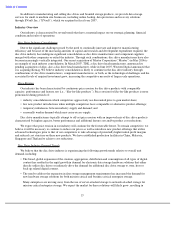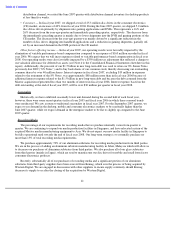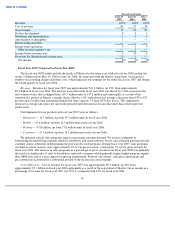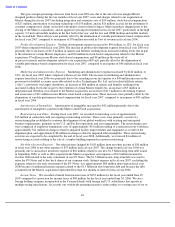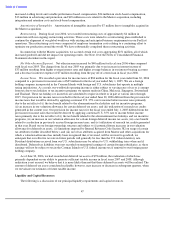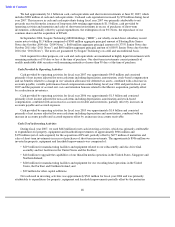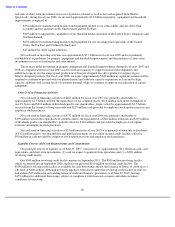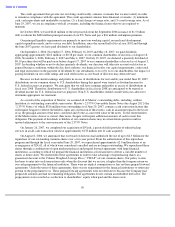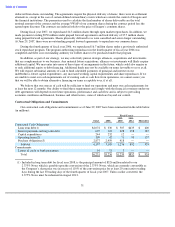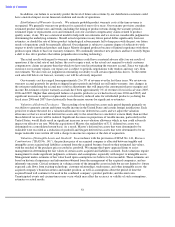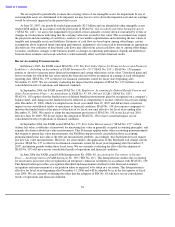Seagate 2006 Annual Report Download - page 50
Download and view the complete annual report
Please find page 50 of the 2006 Seagate annual report below. You can navigate through the pages in the report by either clicking on the pages listed below, or by using the keyword search tool below to find specific information within the annual report.
Table of Contents
increased staffing levels and variable performance-based compensation, $24 million in stock-based compensation,
$13 million in advertising and promotion, and $18 million in costs related to the Maxtor acquisition, including
integration and retention costs and stock-based compensation.
Amortization of Intangibles. Amortization of intangibles increased by $7 million due to intangibles acquired in
the Maxtor acquisition.
Restructuring. During fiscal year 2006, we recorded restructuring costs of approximately $4 million in
connection with our ongoing restructuring activities. These costs were related to a restructuring plan established to
continue the alignment of our global workforce with existing and anticipated business requirements in our Far East
operations. The restructuring costs were comprised of employee termination costs relating to a continuing effort to
optimize our production around the world. We have substantially completed these restructuring activities.
In connection with the Maxtor acquisition, we accrued certain exit costs aggregating $251 million, all of which
increased goodwill and did not impact our operating results. See Note 10 of the Notes to Consolidated Financial
Statements elsewhere in this report.
Net Other Income (Expense). Net other income increased by $40 million for fiscal year 2006 when compared
with fiscal year 2005. The change from fiscal year 2005 was primarily due to an increase in interest income of
$33 million resulting from higher average interest rates and higher average balances in our interest bearing accounts
and a decrease in interest expense of $7 million resulting from the pay off of a term loan in fiscal year 2006.
Income Taxes.
We recorded a provision for income taxes of $84 million for the fiscal year ended June 30, 2006
compared to a provision for income taxes of $25 million for the fiscal year ended July 1, 2005. We are a foreign
holding company incorporated in the Cayman Islands with foreign and U.S. subsidiaries that operate in multiple
taxing jurisdictions. As a result, our worldwide operating income is either subject to varying rates of tax or is exempt
from tax due to tax holidays or tax incentive programs we operate under in China, Malaysia, Singapore, Switzerland
and Thailand. These tax holidays or incentives are scheduled to expire in whole or in part at various dates through
2015. Our provision for income taxes recorded for the fiscal year ended June 30, 2006 differed from the provision for
income taxes that would be derived by applying a notional U.S. 35% rate to income before income taxes primarily
due to the net effect of (i) the tax benefit related to the aforementioned tax holidays and tax incentive programs,
(ii) an increase in our valuation allowance for certain deferred tax assets, and (iii) utilization of research tax credits
generated in the current year. Our provision for income taxes for the fiscal year ended July 1, 2005 differed from the
provision for income taxes that would be derived by applying a notional U.S. 35% rate to income before income
taxes primarily due to the net effect of (i) the tax benefit related to the aforementioned tax holidays and tax incentive
programs, (ii) an increase in our valuation allowance for certain foreign deferred income tax assets, (iii) a tax benefit
related to a reduction in previously accrued foreign income taxes, and (iv) utilization of research tax credits generated
in that year. Based on our foreign ownership structure and subject to (i) potential future increases in our valuation
allowance for deferred tax assets, (ii) limitations imposed by Internal Revenue Code Section 382 on usage of certain
tax attributes (further described below), and (iii) use of tax attributes acquired from Maxtor and other acquisitions for
which a valuation allowance has initially been recognized that, if reversed, will be reversed to goodwill, we
anticipate that our effective tax rate in future periods will generally be less than the U.S. federal statutory rate.
Dividend distributions received from our U.S. subsidiaries may be subject to U.S. withholding taxes when and if
distributed. Deferred tax liabilities were not recorded on unremitted earnings of certain foreign subsidiaries, as these
earnings will not be subject to tax in the Cayman Islands or U.S. federal income tax if remitted to our foreign parent
holding company.
As of June 30, 2006, we had recorded net deferred tax assets of $78 million, the realization of which was
primarily dependent on our ability to generate sufficient taxable income in fiscal years 2007 and 2008. Although
realization is not assured, we believe that it is more likely than not that these deferred tax assets will be realized. The
amount of deferred tax assets considered realizable, however, may increase or decrease in subsequent quarters, when
we reevaluate our estimates of future taxable income.
Liquidity and Capital Resources
The following is a discussion of our principal liquidity requirements and capital resources.
47


